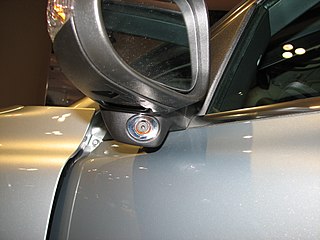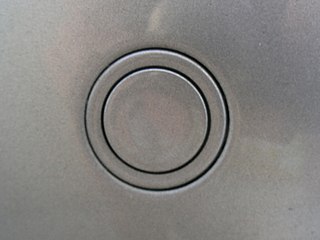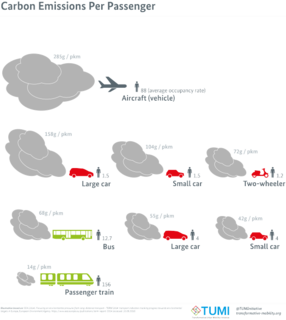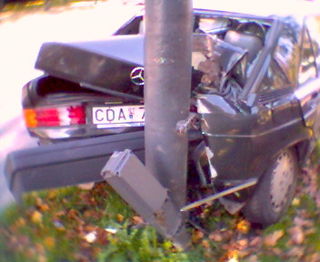Related Research Articles

An intelligent transportation system (ITS) is an advanced application which aims to provide innovative services relating to different modes of transport and traffic management and enable users to be better informed and make safer, more coordinated, and 'smarter' use of transport networks.

Cruise control is a system that automatically controls the speed of a motor vehicle. The system is a servomechanism that takes over the throttle of the car to maintain a steady speed as set by the driver.

Automotive safety is the study and practice of design, construction, equipment and regulation to minimize the occurrence and consequences of traffic collisions involving motor vehicles. Road traffic safety more broadly includes roadway design.
Automotive engineering, along with aerospace engineering and naval architecture, is a branch of vehicle engineering, incorporating elements of mechanical, electrical, electronic, software, and safety engineering as applied to the design, manufacture and operation of motorcycles, automobiles, and trucks and their respective engineering subsystems. It also includes modification of vehicles. Manufacturing domain deals with the creation and assembling the whole parts of automobiles is also included in it. The automotive engineering field is research -intensive and involves direct application of mathematical models and formulas. The study of automotive engineering is to design, develop, fabricate, and test vehicles or vehicle components from the concept stage to production stage. Production, development, and manufacturing are the three major functions in this field.

Electronic stability control (ESC), also referred to as electronic stability program (ESP) or dynamic stability control (DSC), is a computerized technology that improves a vehicle's stability by detecting and reducing loss of traction (skidding). When ESC detects loss of steering control, it automatically applies the brakes to help steer the vehicle where the driver intends to go. Braking is automatically applied to wheels individually, such as the outer front wheel to counter oversteer, or the inner rear wheel to counter understeer. Some ESC systems also reduce engine power until control is regained. ESC does not improve a vehicle's cornering performance; instead, it helps reduce the chance of the driver losing control of the vehicle.

Telematics is an interdisciplinary field that encompasses telecommunications, vehicular technologies, electrical engineering, and computer science. Telematics can involve any of the following:

Advanced driver-assistance systems (ADAS) are electronic systems that assist drivers in driving and parking functions. Through a safe human-machine interface, ADAS increase car and road safety. ADAS systems use automated technology, such as sensors and cameras, to detect nearby obstacles or driver errors, and respond accordingly.

In road-transport terminology, a lane departure warning system (LDWS) is a mechanism designed to warn the driver when the vehicle begins to move out of its lane on freeways and arterial roads. These systems are designed to minimize accidents by addressing the main causes of collisions: driver error, distractions and drowsiness. In 2009 the U.S. National Highway Traffic Safety Administration (NHTSA) began studying whether to mandate lane departure warning systems and frontal collision warning systems on automobiles.
A tire-pressure monitoring system (TPMS) is an electronic system designed to monitor the air pressure inside the pneumatic tires on various types of vehicles. A TPMS reports real-time tire-pressure information to the driver of the vehicle, either via a gauge, a pictogram display, or a simple low-pressure warning light. TPMS can be divided into two different types – direct (dTPMS) and indirect (iTPMS). TPMS are provided both at an OEM (factory) level as well as an aftermarket solution. The goal of a TPMS is avoiding traffic accidents, poor fuel economy, and increased tire wear due to under-inflated tires through early recognition of a hazardous state of the tires. This functionality first appeared in luxury vehicles in Europe in the 1980s, while mass-market adoption followed the USA passing the 2000 TREAD Act after the Firestone and Ford tire controversy. Mandates for TPMS technology in new cars have continued to proliferate in the 21st century in Russia, the EU, Japan, South Korea and many other Asian countries. As of November 2014, fitment rate stands at 54% of passenger cars.
An event data recorder (EDR), similar to an accident data recorder (ADR) sometimes referred to informally as an automotive "black box", is a device installed in some automobiles to record information related to vehicle crashes or accidents. In the USA EDRs must meet federal standards, as described within the U.S. Code of Federal Regulations.

The blind spot monitor is a vehicle-based sensor device that detects other vehicles located to the driver’s side and rear. Warnings can be visual, audible, vibrating, or tactile.

Parking sensors are proximity sensors for road vehicles designed to alert the driver of obstacles while parking. These systems use either electromagnetic or ultrasonic sensors.

Vehicle Safety Technology (VST) in the automotive industry refers to the special technology developed to ensure the safety and security of automobiles and their passengers. The term encompasses a broad umbrella of projects and devices within the automotive world. Notable examples of VST include geo-fencing capabilities, remote speed sensing, theft deterrence, damage mitigation, vehicle-to-vehicle communication, and car-to-computer communication devices which use GPS tracking.

Energy-efficient driving techniques are used by drivers who wish to reduce their fuel consumption, and thus maximize fuel efficiency. The use of these techniques is called "hypermiling".
Intelligent speed adaptation (ISA), also known as alerting, and intelligent authority, is any system that ensures that vehicle speed does not exceed a safe or legally enforced speed. In case of potential speeding, a human driver can be alerted, or the speed reduced automatically.

A collision avoidance system (CAS), also known as a pre-crash system, forward collision warning system, or collision mitigation system, is a motorcar safety system designed to prevent or reduce the severity of a collision. In its basic form, a forward collision warning system monitors a vehicle's speed, the speed of the vehicle in front of it, and the distance between the vehicles, so that it can provide a warning to the driver if the vehicles get too close, potentially helping to avoid a crash. Various technologies and sensors that are used include radar (all-weather) and sometimes laser (LIDAR) and cameras to detect an imminent crash. GPS sensors can detect fixed dangers such as approaching stop signs through a location database. Pedestrian detection can also be a feature of these types of systems.

Back-up collisions happen when a driver reverses the car into an object, person, or other car. Although most cars come equipped with rear view mirrors which are adequate for detecting vehicles behind a car, they are inadequate on many vehicles for detecting small children or objects close to the ground, which fall in the car's blind spot, particularly directly aft. That area has been called a "killing zone." Large trucks have much larger blind spots that can hide entire vehicles and large adults.
Honda Advanced Technology is part of Honda's long-standing research and development program focused on building new models for their automotive products and automotive-related technologies, with many of the advances pertaining to engine technology. Honda's research has led to practical solutions ranging from fuel-efficient vehicles and engines, to more sophisticated applications such as the humanoid robot, ASIMO, and the Honda HA-420 HondaJet, a six-passenger business jet.
Driver drowsiness detection is a car safety technology which helps prevent accidents caused by the driver getting drowsy. Various studies have suggested that around 20% of all road accidents are fatigue-related, up to 50% on certain roads.
A connected car is a car that can communicate bidirectionally with other systems outside of the car (LAN). This allows the car to share internet access, and hence data, with other devices both inside and outside the vehicle. For safety-critical applications, it is anticipated that cars will also be connected using dedicated short-range communications (DSRC) radios, operating in the FCC-granted 5.9 GHz band with very low latency.
References
- ↑ Lincoln, Gubba, Yvonna, Egon (1985). Naturalistic Inquiry . California, USA: Sage Publications, Inc. ISBN 978-0-8039-2431-4.
- ↑ "euroFOT Final Event: Unveiling the results of the first large-scale FOT of ADAS in Europe". ERTICO. June 27, 2012. Archived from the original on March 7, 2014. Retrieved March 1, 2014.
- ↑ "EuroFOT". FOT-net. December 3, 2013.
- ↑ EuroFOT Final Report, 2019-09-20, retrieved 2020-01-23 https://eurofot-ip.eu/en/library/deliverables/sp1_d113_final_report.htm
- ↑ Crowe, Philippe (June 27, 2012). "EuroFOT Project Confirms Usefulness Of Driver Assist Systems". hybridCars.
- ↑ "euroFOT study demonstrates how driver assistance systems can increase safety and fuel efficiency". Green Car Congress. June 26, 2012.
- ↑ "Volvo's new safety technologies reduce risk of rear-end impacts by up to 42 percent". The Philippine Star. July 18, 2012.